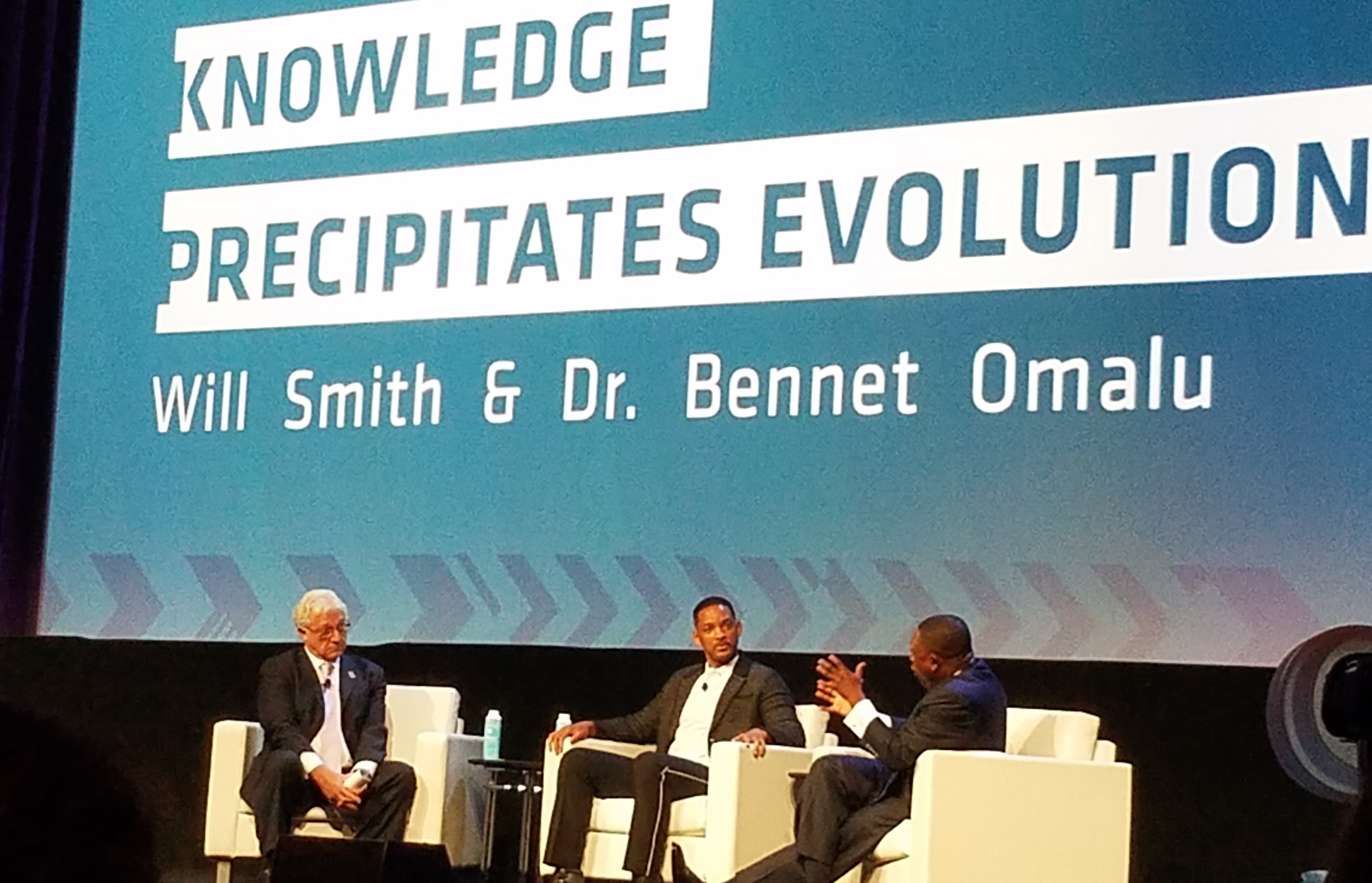
by Lidia Paulinska | Sep 13, 2016
Biotechnology, September 2016 – The opening keynote for Biotechnology conference in San Francisco this past June was a brilliant pairing of two speakers – Forensic pathologist Dr Bennet Omalu and famous actor Will Smith.
What brought them together? The answer is – cinema.
Both of them are the characters of the movie “Concussion” that was released at the end of 2015 and many claimed that it deserved an Oscar nomination. It is the story of Dr Bennet Omalu (portrayed by Will Smith in the movie) who discovered and described a disease called CTE – Chronic Traumatic Encephalopathy after a few dramatic accidents resulted in the early deaths of football players in Pittsburgh. For those who haven’t seen the movie I save writing a review, because it is worth going to see.
Dr Bennet Omalu talked on the stage about science for the sake of knowledge and the interrelationship of pure science and its faith. Will Smith talked about his reaction to the film. How he suddenly got concern about his son that likes to play football. Both men are very colorful characters. Omalu’s sense of humor and unstoppable laugh was dominating on the stage. Will Smith was talking about challenges in that role including Omalu’s accent and the laugh.
The film opened the public eyes at the challenges that players facing and shake the NFL world. Omalu who is dedicated to the science as investigating how the world works, and to this end, used his own money to investigate why the admired Steeler team football player Mike Webster, ended up his life alone, homeless and in unbearable pain. Omalu kept asking why that happened and why at so early an age. The road to acceptance of the discovery wasn’t easy but Omala believed and searched for truth no matter what.
As many attendees came being attracted by Will Smith presence they were taken by surprise and found Dr Bennet Omalu very interesting and compiling person.
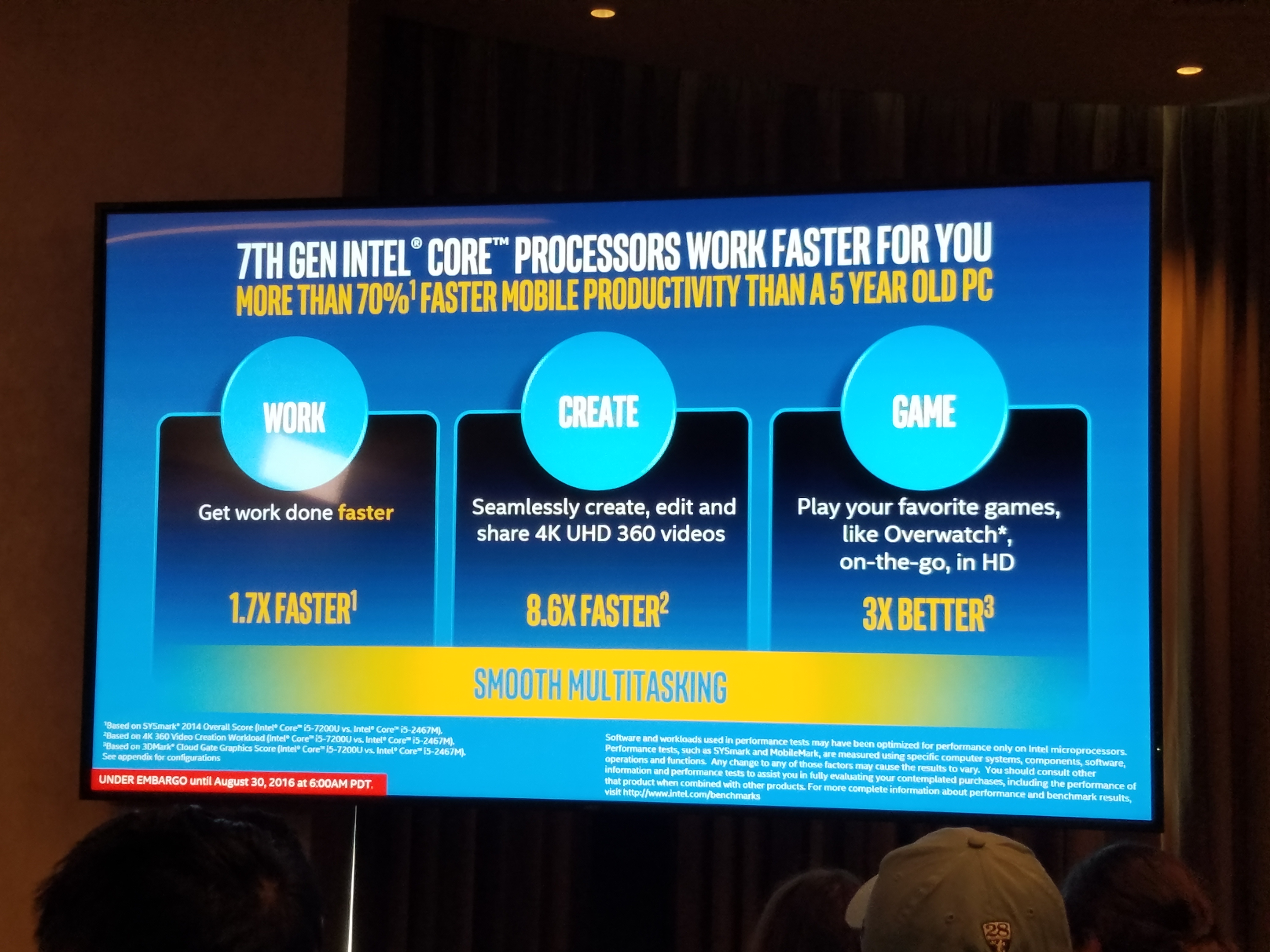
by Lidia Paulinska | Sep 9, 2016
IDF, September 2016 – At the Intel Developer Forum, while a lot of the discussion was on IoT and smart connections, Intel continued their technology advancement and development of multi-core processors for the consumer computer market. The company held a briefing to announce their 7th generation Core series microprocessor.
The new processors continued the take advantage of the new process technology. The processors use the Intel 14nm+ technology which is an updated and advanced version of the 14nm process released a short time back. This new process is about 12% faster than the standard 14nm process and allows for increased productivity in the design. The new process is not only faster but also lower power so the designs of the new PC’s using them can be thinner and lighter with longer battery life.
The higher density design on the 14nm+ process allowed for the addition of a new graphics engine to be built into the chip that will now support UHD 4K video without an additional external GPU card or chip. This will all the computers for be used for immersive applications such as VR, and high resolution movies.
This year, there are supposed to be over 100 designs from multiple manufacturers that will be released with the new core generation core processors. These designs now support new standard functions such as USB 3.1, Thunderbolt 3, Windows Hello, a pen/stylus, and 4K display panels. These will enhance both gaming/entertainment and standard office productivity. The computers with the new processors, and supporting the new DDR4 DRAM memory and Flash memory storage solutions, are many times faster and more productive than a computer from as little as 5 years ago.
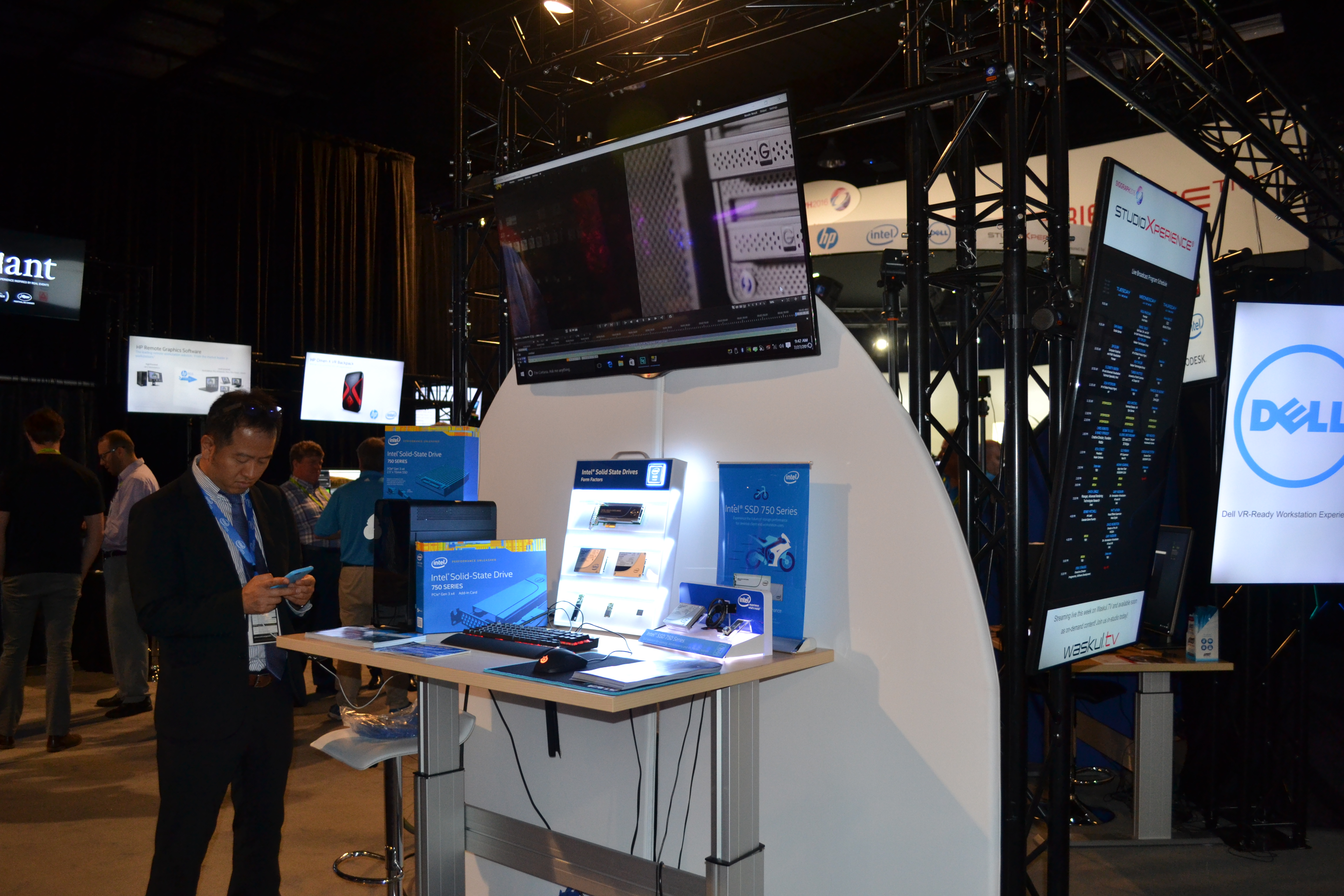
by Lidia Paulinska | Sep 6, 2016
Siggraph, July 2016 – The annual SIGGRAPH event is the meeting place for the academics, innovators, industry and professional media producers to meet and share their experiences. The commonality is the blending of the technology and engineering with the artistic vision that drive cinema, TV and advertising. To help realize these visions on a release schedule, the computers used had to change and became workstations.
Dell’s Precision Workstations had a lot of visibility at the SIGGRAPH 2016 show even though Dell did not have a booth on the show floor and the company did not introduce any new products. We living on providing solutions – said Molly Connolly, WW Industry Strategist, Media & Entertainment – We are looking for symbiotic microcosms. She confirmed that the company understands the balance with software professional community and also their customers. Her focus is on how we can engage with the community and listen what their needs are to make their workstations even better.
Dell’s workstation is a solution for the SIGGRAPH community.
The facts are that you don’t need the workstation if you are just running office and email but everyone who is creating visual and digital content, and those who are using the professional applications for creating the digital content; those professionals need system commonality, multi-processors with multiple cores, ECC memory, professional graphics compute capability, fast storage, fast IO & networking. All that workstation provides.
Workstation are for time critical applications and they are designed not to fail and require the user re-crate the content. If you running a 3 day rendering task, and you know that your film has to be in theaters in 8 weeks, the workstation is the solution for you. The same for broadcasting space. Broadcast cannot let the screen go dark or have the content interrupted.
Dell’s workstations for M&E Tech space enables the magic to happen – said Molly. Dell’s workstation has been used by the last five winner of Academy Awards for Visual Effects. Molly went on to state that – “We’ve been very fortunate. Dell precision workstation has been recognized as leader in performance.” This recognition has been for both the desktop and portable workstations.
This capability is what is driving Dell as one of the dominant platforms for the creation of VR content. The workstations are designed to support all the pieces needed for this new stereoscopic and 360 degree content marketplace, and are being quickly adopted as the computer of choice for the VR creators.
Looking at the process. Artists create the content – mostly at the workstation, they manage the content – typically on server, then they deliver the content and you enjoy it (or consume it). The workstations, with their fault tolerant design, construction for long hours of continuous operation and capacity for high performance computing allow this process to happen on a predictable schedule, freeing the artists to create their vision, rather than worry about the computing.
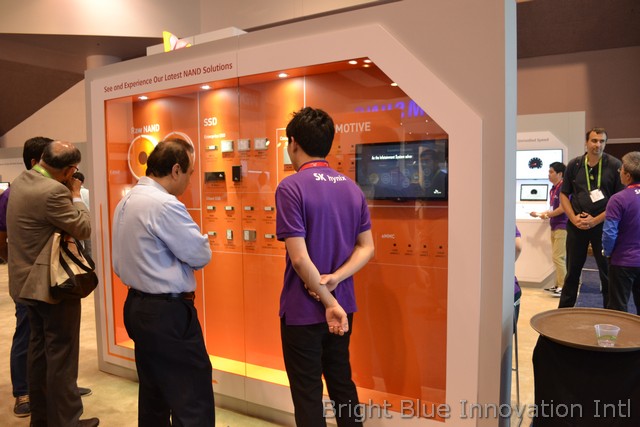
by Tom P Kolodziejak | Sep 5, 2016
Flash Memory Summit, August 2016 – The process of consumerization of flash memory started around 2004. This year NAND prices drop below DRAM prices for the first time at the same density. Panasonic and Sanyo launched the first flash-based camcorders. SanDisk inaugurated Flash Sansa MP3 players. In 2005 NAND revenue exceeded $10 billion when Apple introduced its first iProducts.
Below is the timeline of consumerization of flash memory.
2005 – Apple introduced its first two flash-based iPods, the iPod shuffle and the iPod nano. Microsoft launched Hybrid Hard Disk Drive concept. MMCmicro card was introduced by MMCA. 70nm process was initiated. Micron introduced NAND product. Over 3 billion flash chips were shipped. NAND GB shipments overtook those of DRAM.
2006 – Flash revenue exceed $20 billion. Intel introduced Robson Cache Memory, now known as Turbo Memory. Microsoft launched ReadyBoost. M-Systems announced 4-bit MLC technology. That was an important year for SanDisk. The company announced 4-bit NAND technology and the microSDHC card. SanDisk acquired two enterprises: Martix Semiconductor and M-Systems. Samsung and Seagate demonstrated first Hybrid Hard Disk Drives. IMFT was formed by Intel and Micron to manufacture NAND flash. Spansion introduced ORNAND flash. 56nm process was announced. 300 mm wafers started to be produced.
2007 – Flash revenue exceeded $22 billion (NAND $14.5B) Toshiba introduced eMMC NAND and first MLC SATA-based SSD. IMFT started shipping 50nm NAND flash. Apple launched the iPhone with 4GB or 8GB of flash. Fusion-io announced 640 GB ioDrive MLC NAND-based PCIe X4 board. BitMicro launched 3.5”SSD with capacity of 1.6TB for military applications. Spansion acquired Saifun. Several laptop MLC SSDs were introduced with up to 128 GB of flash. Dell launched SSD option for laptop models. Sub-$200 netbook computers were introduced with flash memory storage. Microsoft initiated flash-based Zune Player. Seagate launched the Hybrid Storage Alliance and the first hybrid HDD, the Momentus PSD.
2008 – SanDisk introduced ABL to enable high speed MLC, TLC and X4 NAND. 34nm process announced by Intel and Micron. Toshiba initiated first 512GB MLC SATA-based SSD. Intel and STMicro spanned off Numonyx. IBM demonstrated first “Million IOPS” flash array. EMC announced use of flash-based SSDs for enterprise SAN applications. Apple introduced two generations of MacBook Air, with 64GB and 128GB SSDs and no HDD option. Micron, Samsung and Sun Microsystems announced high-endurance flash memory. Violin introduced first fully flash-based storage appliance. Samsung announced 150GB 2.5”MLC SSD with SATA II Interface. Several companies demonstrated MLC flash SSDs with up to 256GB for notebook apps. Micron introduced first serial NAND flash. Toshiba developed 3D NAND structure, BICS. Apple sold 1M iPhone 3Gs in 3 days, with 8GB or 16GB of flash.
2009 – Intel, Micron introduced 34nm TLC NAND. Samsung introduced the first full HD camcorder with a 64GB SSD. Seagate entered SSD market. SandForce introduced first compression-based SSD controller. Virident and Schooner launched first flash-based application appliances for the data center. Pillar Data converted Axiom SANs to SSD. Plaint introduced first SAS SSD. SanDisk shipped 4-bit/cell SDHC and Memory Stick Pro cards. Western Digital acquired SiliconSystems and got into SSD business. NVELO introduced first PC flash caching software “Dataplex’. SanDisk introduced 100-year flash storage vault. The revenue reached 19 billion.
2010 – Toshiba introduced 128GB SDcard based on sixteen-chip stack. Intel, Micron introduced 25nm TLC and MLC NAND. Numonyx was acquired Micron, SST by Microchip. Samsung started producing 64 Gb, 3-bit NAND and introduced high-speed 512 GB SSD utilizing toggle-mode DDR NAND memory. Seagate announced first self-managed hybrid HDD, the Momentus XT with 4GB of NAND flash and 500GB HDD storage. The revenue reached $26 billion.
2011 – Year of many acquisitions: LSI acquired SandForce; SanDisk acquired IMFT, Apple acquired Anobit, Fusion-io acquired IO Turbine. Intel announced Smart Response SSD caching for PCs. Seagate introduced II generation Momentus XT hybrid HDD with 8GB of NAND flash and 750GB HDD storage. Richard Pashley, Stefan Lai, Bruce McCormick and Niles Kynett from Intel received FMS Lifetime Achievement Award.
2012 – Ultrabooks begin to ship with Smart Response SSD cache. SanDisk and Toshiba announced 19nm flash memory enabling 128Gb chips. Macronix and Winbond entered NAND flash business. Seagate introduced SSHD combining flash memory with a HDD. Elpida introduced ReRAM. Micron and Intel launched 20nm 128Gb NAND chip using hi-k planar cell. SK Hynix formed upon SK Telecom’s acquisition of controlling interest in Hynix Semicondactor. MOSAID sampled 333GB/s HL-NAND. Adesto acquired Atmel’s Serial NOR business. Spansion introduced 8Gb NOR chip. DensBits Technologies introduced Memory Modem. Proximal Data introduced AutoCache. SanDisk acquired FlashSoft. OCZ acquired Sanrad. Samsung acquired NVELO. Intel acquired Nevex and introduced CacheWorks. LSI introduced Nytro flash with MegaRAID CacheCade caching software. Micron introduced 2.5-inch PCIe enterprise SSD. SanDisk co-founder, Eli Harari, received FMS Lifetime Achievement Award.
2013 – Samsung announced availability of 24-layer 3D V-NAND and demonstrated 1TB SSD at FMS 2013. Diablo Technologies announced Memory Channel Storage technology. SMART Storage Systems incorporated Diablo Technologies designs into ULtraDIMM. Western Digital and SanDisk introduced SSHD using iSSSD combined with an HDD. Toshiba introduced line of SSHDs. Everspin Technologies announced shipments of STT MRAM. Micron and other companies sampled 16nm flash memory. SanDisk released CFast 2.0 memory card, fastest memory card for professional video. M.2 PCIe interface formalized NVMe standard issued to accelerate communications with flash storage. Western Digital acquired sTec, Virident and Velobit. SanDisk acquired SMART Storage Systems. NVMdurance introduced software to extend flash endurance. Micron acquired Elpida. Intel introduced Intel Cache Acceleration Software. Fujio Masuoka, formerly of Toshiba, received FMS Lifetime Achievement Award. The revenue reached $30 billion.
2014 – Samsung, SanDisk and Toshiba announced 3D NAND production facilities. SanDisk introduced 4TB Enterprise SSD. SanDisk announced 128GB microSD card, a 1000x increase in capacity on device’s 10th anniversary. IBM announced eXFlash DIMMs using SanDisk ULLtraDIMM’s implementation of Diablo Memory Channel Storage technology. Samsung rolled out II generation of 3D V-NAND with 32 layers. Spansion introduced HyperFlash NOR with 333 MB/s HyperBus. Toshiba acquired OCZ. Everspin introduced and ramped production of ST-MRAM. Samsung introduced 3-bit/cell 3D NAND SSDs. Adesto shipped one-millionth CBRAM. SK Hynix acquired Violin’s PCIe SSD business. Seagate acquired LSI/Avago storage business. SanDisk acquired Fusion-io. HGST acquired Skyera. Samsung acquired Proximal Data. Simon Sze, formerly of Bell Labs, received FMS Lifetime Achievement Award.
2015 – SanDisk introduced InfinitiFlash storage system. Cypress Semiconductor acquired Spansion. Toshiba and SanDisk announced 48-layer 3D NAND. Intel and Micron announced 384Gb 3D NAND. Samsung introduced first NVMe m.2 SSDs and 4 B layer V-NAND. SanDisk introduced 200GB microSDXC UHS-I-card. Cypress introduced 4MB serial FRAM. Intel and Micron announced 3D XPoint Memory. Intel introduced XPoint-based “Optane” DIMMs and SSDs. Bob Norman, formerly of SanDisk and Micron received FMS Lifetime Achievement Award. The revenue reached $35 billion.
2016 – SK Hynix sampled 3D NAND m.2 NVMe SSD. XMC broke ground on first China-owned NAND flash fab. Micron presented 768Gb 3D NAND. Western Digital acquired SanDisk. Micron shipped 3D NAND. Everspin announced 256Mb MRAM chips and 1 Gb chips by the end of year. IBM adopted TLC to PCM. Samsung shipped 48-layer 3D NAND. Kinam Kim, President System LSI/Semiconductor Business, Samsung received FMS Lifetime Achievement Award.
The revenue for 2016 is estimated to reach $37 billion.
Information from Flash Memory Summit. Flash revenue numbers provided by Objective Analysis.
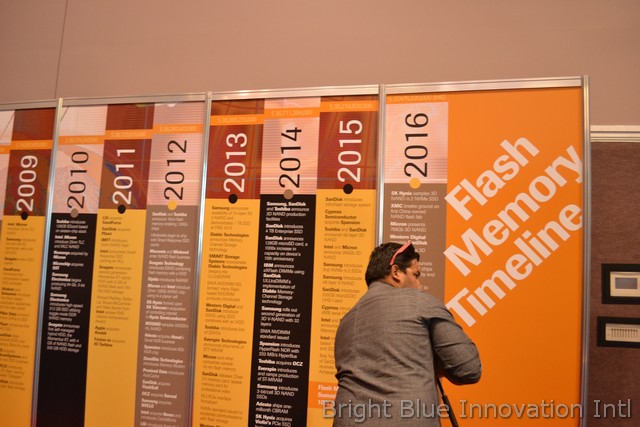
by Tom P Kolodziejak | Sep 5, 2016
Flash Memory Summit, August 2016 – Flash memory is the enabling technology for most of the mobile devices today. It allows for very high capacities of storage for things like music, voice, photos and videos to be stored for long periods of time, without needing power to store the information when it is not being used.
Eli Harari, who holds over 100 patents and has widespread recognition (including IEEE Reynold B. Johnson Data Storage device Technology Award in 2006 and IEEE Robert N. Noyce Medal in 2009), described flash memory as descriptive technology in that time. This descriptive technology enabled consumer applications such as cellphones, digital cameras, music players etc. that we enjoy today and they shape our lives. Here is a timeline of history of flash memory development.
The beginning of successful story of flash memory started at Bell Laboratories. In 1967 Kahng and Sze invented the floating gate memory device which allows a transistor to remember a digital value of 0 or 1, without power, until it is ready to be checked. Few years later Eli Harari of Hughes Electronics filed for first practical floating gate EEPROM (Electrically Erasable Programmable Read Only Memory) using thin SiO2 and using the electron characteristic of Fowler Nordheim tunneling for program and erase.
In 1978 Hughes Electronics introduced first CMOS NOVRAM 256-bit chip (non-volatile SRAM) and two years later the 1980, first CMOS EEPROM 8Kbit chip was released. Both of these chips used Fowler Nordheim floating gate EEPROM technology. In 1980 Intel introduced the Intel2816, a 16K bit HMOS EEPROM with Fowler Nordheim tunneling and 3 years later the Intel2817A 16K bit EEPROM. While these chips were in the marketplace, the first paper describing flash EEPROM was presented by Fujio Masuoka of Toshiba at IEEE International Electron Devices Meeting (IEDM) in San Francisco in 1984, the year after Exel filed patent for the first NOR organized flash memory cell. In 1986 Intel introduced the flash card concept with ECC and on-card controller and the company formed unit focusing on solid state drives.
The flash memory industry financial success started grown rapidly at the end of the 1980s ($1.6M in 1987; $6.4M in 1988; $25M in 1989) followed by many inventions and patents.
1987 – Fujio Masuoka of Toshiba presented first NAND-type flash memory technology at IEDM. Intel invented first Flash File System concept and introduced NOR flash chips.
1988 – Early EEPROM inventor/investigator Elli Harari along with Sanjay Mehrotra and Jack Yuan founded SunDisk (later the name was changed to SanDisk) in 1988 to develop new “system Flash” architecture combining embedded controller, firmware and flash memory to emulate disk storage. The company filed the first two MLC (Multi-level-cell) flash patents. JPEG and MPEG standards allowed economical production of digital cameras and first flash-based digital camera, Fuji DS-1P was demonstrated. Intel sampled 1Mb NOR flash. Intel and Psion designed flash-based mobile PC.
1989 – SunDisk filed System Flash patent. M-Systems was founded and shorty after introduced the Flash Disk concept, that was precursor to flash SSDs. The same year Intel shipped 512K and 1Mb NOR flash. Psion introduced flash-based PC. Microsoft joined effort with Intel and introduced its Flash File System. Western Digital and SunDisk launched a NOR-based Flash SSD fully emulating a traditional rotating ATA HDD.
At Comdex (Computer Dealers’ Exhibition), the largest computer trade show in the world (precursor of today’s CES) that was held in Las Vegas, DiGiPro introduced 8Mb NOR Flashdisk. The flash industry reached 100 million parts shipped and made many introductions such as EReader by Sony, camera prototypes by Kodak, 1MB and 4MB linear flash PCMCIA card and 2Mb NOR chip by Intel, first NOR flash SSD: 20MB 2.5”, fully compatible with Conner Peripherals 2.5” ATA HDD. This year also PCMCIA set standard on ATA PC card form factor and pinout, using SunDisk “System Flash” specification for full HDD compatibility.
At the beginning of 1990 flash memory industry expanding amazingly fast like never before and the revenue grown from $170 million in 1991, $295 million in 1992, $505 million in 1993, $864 million in 1994 and reached over $1.8 billion in 1995.
1991 – Toshiba developed world’s first 4 Mb NAND flash. Kodak shipped DCS-100, its first DSC at $13,000. Zenith Poqet and HP showed palm-sized notebook computers using flash memory cards at Spring Comdex.
1992 – Information Storage Devices introduced flash based voice recorder chip. AMD and Fujitsu released its first NOR product. M-Systems demonstrated TrueFFS that was adopted later by the PCMCIA as FTL. That was a year when Intel launched few products including: second generation FFS2, 8Mb flash chip, 4MB-20MB linear flash memory cards and 1Mb “boot bloc” NOR flash with sectors for BIOS applications – first use of internal write state machine to manage flash write algorithm. SunDisk introduced first serial 9Mb NOR Flash chip for SSD applications. Starting 1992 PCs began using flash for BIOS storage.
1993 – Datalight introduced “Card Trick” flash management software. Apple initiated the use of NOR flash in their Newton PDA. Intel inaugurated 16Mb and 32Mb NOR flash. Intel and Conner jointly developed 5MB/10MB ATA flash disk drive. AMD introduced 5-volt-only NOR using negative gate erase.
1994 – SunDisk presented CompactFlash card and 18Mb serial NOR Flash chip for SSD applications. Norris Communications introduced Flashback, the first portable digital voice recorder with flash memory.
1995 – Casio launched the QV-11 digital camera with flash rather than film or floppy. Mitsubishi introduced DiNOR. M-Systems initiated flash-based Solid State Drives and NOR-based DiskOnChip. SunDisk that changed the name to SanDisk introduced 34Mb Serial NOR Flash, first MLC flash chip for SSD applications.
In 1996 flash memory revenues reached $2.6 billion and noted 163% growth in 10 years.
1996 – Toshiba introduced SmartMedia Memory Card also called Solid State Floppy Disk Card. Samsung started shipping NAND flash. Kodak DC-25 was first DSC with CompactFlash card. Datalight launched “FlashFX” flash management software supporting NOR and NAND in the single driver. SanDisk initiated first flash cards with MLC serial NOR. Palm introduced flash-memory-based PDA.
1997 – First cell phones were shipped with flash memory. SaeHan Information Systems presented flash-based MPMan MP3 player. SanDisk and Siemens introduced the MultiMedia Card (MMC and MMCplus). Sony demonstrated the Memory Stick. M-Systems launched NAND based DiskOnChip/200 mm wafers began production/500 million flash chips were shipped. Intel introduced 2-bit/cell 64 Mb MLC StrataFlash.
1998 – NOR revenue exceeded $2 billion. 250nm process was announced. SaeHan Information Systems and licensee Eiger shipped world’s first mass-produced MP3 player (MPMan) with 32MB. Diamond Rio demonstrated its PMP300 MP3 player. Panasonic, SanDisk and Toshiba launed SD card.
1999 – NOR revenue exceeded $4 billion. Toshiba and SanDisk created flash memory manufacturing joint venture. Micron announced NOR products/over 1 billion flash chips were shipped. Dov Moran of M-Systems applied for patent on a USB-based flash drive.
2000 – Flash (NOR and NAND) revenue exceeded $10 billion. M-Systems (working with IBM) and Trek Technology introduced USB flash drives. Intel shipped its one billion flash unit/160nm process was announced.
2001 – NAND revenue exceeded $1 billion. Toshiba and SanDisk announced 1Gb MLC NAND. SanDisk by itself introduced first NAND System Flash product. Hitachi launched AG-AND. Samsung began mass production of 512Mb flash memory device.
2002 – Olympus in the cooperation with FujiFilm presented xD-Picture Card. MMCmobile card was introduce by MultiMediaCard Association (MMCA). Sony and SanDisk jointly launched the Memory Stick PRO and half-size Memory Stick PRO Duo cards. AMD introduced MirrorBit charge trap flash. 130nm process was announced.
2003 – NAND revenue exceeded $5 billion. SanDisk introduced mnSD card. Sony in cooperation with SanDisk launched the Memory Stick PRO Micro. Spansion was created out of AMD and Fujitsu.
2004 – NAND prices drop below DRAM prices for the first time at the same density. SanDisk and M-Systems introduced U3 software system for USB flash drives. SanDisk and Motorola launched the TransFlash card, now known as microSD card. Datalight initiated multi-threaded “FlashFX Pro” management software to support multimedia NAND devices. Spansion introduced MirrorBit Quad 4-bit NOR. The 90nm process node was announced for flash memory production. Hynix and ST Micro formed joint venture and Hynix NAND product was introduced. Infineon NAND product based on Saifun Charge Trap Flash was announced. Panasonic and Sanyo launched the first flash-based camcorders. SanDisk inaugurated Flash Sansa MP3 players.
In 2005 Apple introduced its first two flash-based iPods, the iPod shuffle and the iPod nano. The process of consumerization of flash memory started.
Information from Flash Memory Summit. Flash revenue numbers provided by Objective Analysis.

by Lidia Paulinska | Sep 3, 2016
Fathom events, August 2016 – On Wednesday, August 24, 2016, Fathom events offered a one-night only screening of the classic American film, “Thelma & Louise,” featuring Geena Davis and Susan Sarandon respectively in the title roles. This showing was in celebration of the films 25th anniversary.
Film critic Roger Ebert in his syndicated column of January 1, 1991 praised the film as being a classic in the expansive, visionary tradition of the American road picture. “It celebrates the myth of two carefree souls piling into a 1956 T-Bird and driving out of town to have some fun and raise some hell. We know the road better than that, however, and we know the toll it exacts: Before their journey is done, these characters will have undergone a rite of passage, and will have discovered themselves.
What sets “Thelma & Louise” apart from other great classics of traditional road movie like “Bonnie & Clyde,” “Easy Rider,” and “Rain Man,” and iconic buddy movies such as “Butch Cassidy and the Sundance Kid,” is the fact that the heroes are both women.
They are initially presented as two very ordinary working-class girlfriends, Louise, a waitress at a small Arkansas town who lives with an Elvis look-alike musician, and Thelma, a housewife married to a verbally abusive buffoon who’s a self-important rug salesman. To escape their hum-drum lives, the girls decide to hit the road for a weekend of fun, but through successive, unanticipated events, often hilarious, yet equally as often, toxic and life-changing, the weekend is extended into a microcosm of an almost cosmic release of these two women’s inner, repressed selves. It’s as if we’re witnessing the free-flowing liberation of their inner-most psyches. They bare progressively their souls in the name of freedom throughout their journey and ultimately pay the price. They seem to take on a universal every-woman identity, one which few have the courage or the means to explore.
The film has two additional characters, understandably not included in the credits: the first is the harsh, barren, and unforgiving Bad Lands through which they journey seeking “a good time;” the second equally as harsh and brutal is the overwhelmingly male-dominated milieu in which they live, visually engulfed by big-rigs, 18-wheelers, oil tankers, predatory truck stops and run-down gas stations, all symbolizing the threatening and palpably dangerous environment in which they must survive. It’s all hard-edge and steel and one can almost smell the oil and stench of burning rubber.
But like a couple of unexpected, fragile daisies growing through a pile of concrete rubble, Thelma and Louise grow and mature spiritually in unanticipated ways, precariously pinched between a New Life of self-awareness and utter destruction.
This is not a “chick flick” or “women’s lib” gesture, but rather a ground-breaking cinematic milestone, in what may be viewed as the emergence on the popular screen of the female archetype in which the essence of womankind is given full and very moving expression.
Produced by Ridley Scott & Mimi Polk
Genre: Drama, Road Movie, Thriller
Rated: R
128 minutes
Cast: Susan Sarandon as Louise, Geena Davis as Thelma, Harvey Keitel as Hal and Brad Pitt as J.D. (debut)
Review by Hugh McMahon and Lidia Paulinska
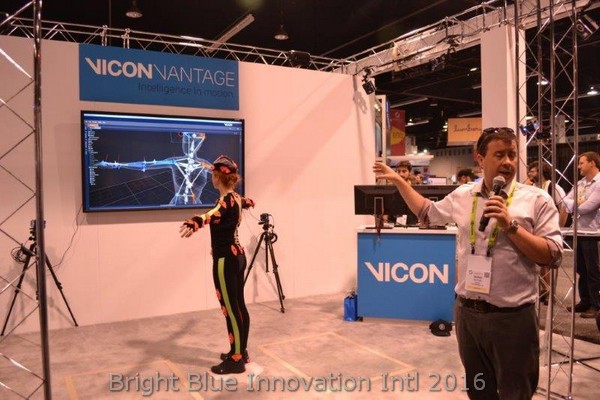
by Lidia Paulinska | Aug 30, 2016
Siggraph, July 2016 – In an interview with Jeffrey Ovadya, Director of Sales and Marketing for Vicon Motion Systems, we got a chance to hear about their latest mocap camera and also Project Katana which was being demonstrated on the conference expo floor at SIGGRAPH 2016.
Motion Capture, or MoCap has moved to the mainstream for VFX production in movies, TV, advertising and most content creation. It has even expanded to support automated PTZ camera movement for live TV production using virtual studios. The primary product from the company is high speed cameras for motion capture that are mounted to a scaffolding system or framing to define a 3D space where the movement is captured. The new cameras and software are designed to be smarter and easier to use, as mocap moves from the professional space to the prosumer market.
For simplicity in the use of mocap, Jeff said that Vicon has started a program called “Project Katana”. The idea behind it is to have a system that in real time will create a mocap skeleton model ad bring the data into systems like Final Cut. The goal is to have final quality, fully rigged and articulated skeletons of the mocap session at the end of each shot. This will provide full skeletons of all characters in the 3D capture space, at the end of each day, along with the production dailies. In order to perform this analysis, the studio setup and network has to be self-healing. The data environment for motion and the rigging connections in the project are being done using a Matlab mathematical modeling core.
The booth at the SIGGRAPH expo was showing the system however there is not release date or a “product name” for when Project Katana will be released.
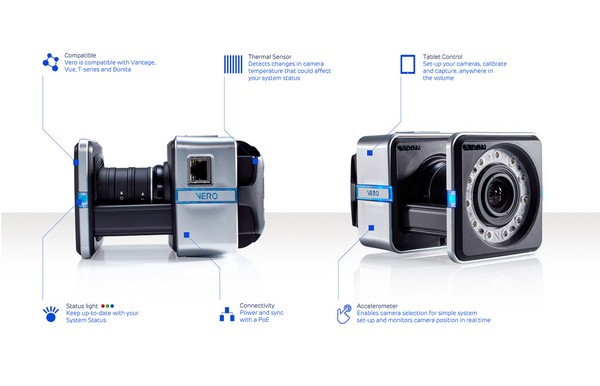
To address this shift towards simplicity, Vicon has introduced the Vero camera. It is available in two models the v1.3 which is a 1.3MP camera and the v2.2 which is a 2.2MP camera. Designed specifically for mocap applications, the cameras are an 850nm IR greyscale camera that operates at either 250FPS for the v1.3 or 330FPS for v2.2. The high frame rates on the cameras allow for real time and full range live motion capture.
The cameras have a variable focus lens from 6mm-12mm for use in low angle and high angle applications. A major design simplification for the user is the single cable connection. The cameras have standard RJ45/Cat5e Ethernet connector that serves to be the interface for the camera control, data connection from the units and power the units using the POE specification. For this single cable connection system, the cameras have been designed to only require 12W to operate. Like the prior generation and larger camera the Vantage, the Vero has on-board sensors that monitor camera position and temperature to ensure optimal performance.
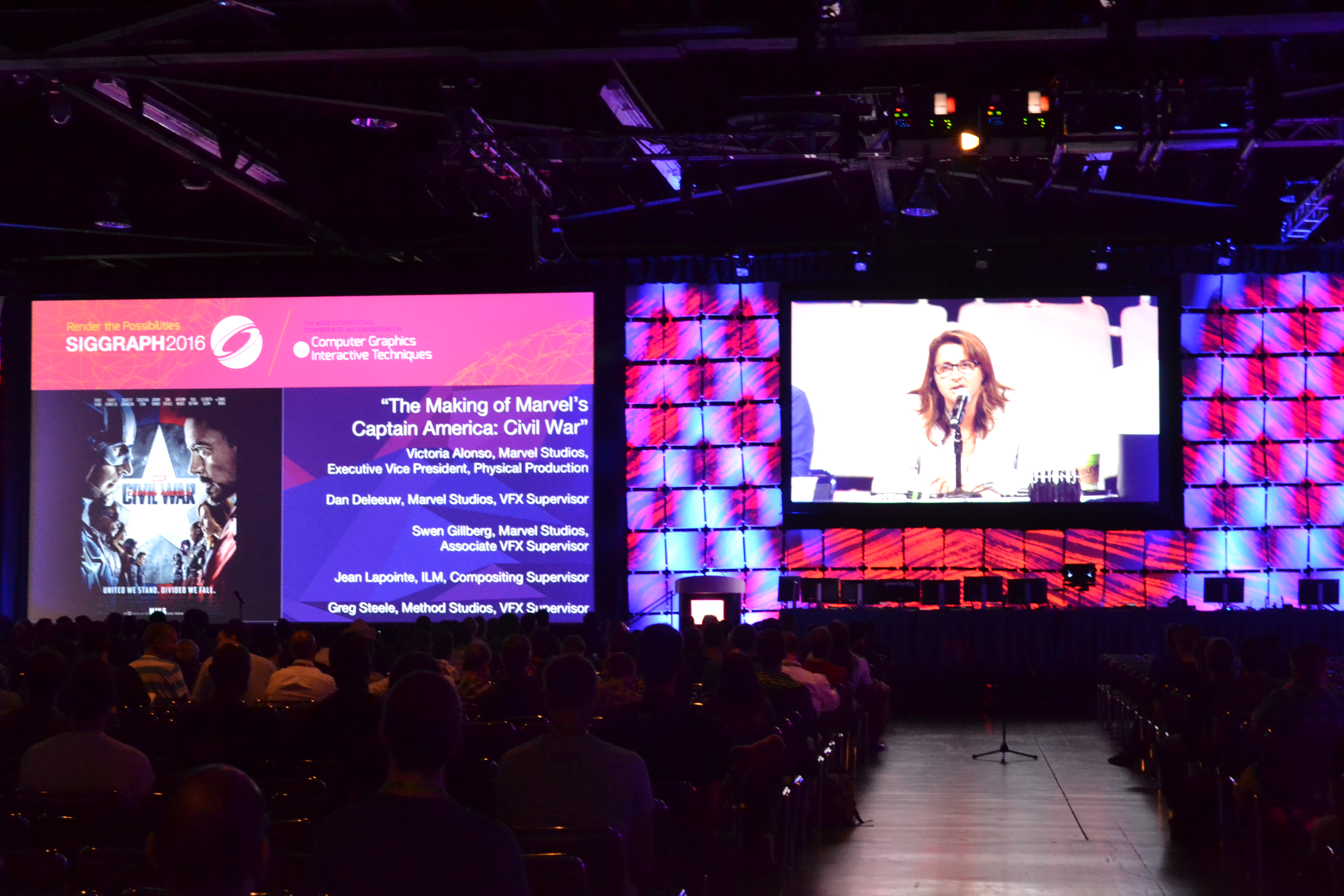
by Lidia Paulinska | Aug 21, 2016
Siggraph, July 2016 – Due to the complexities of scheduling a large cast of actors and crew it is difficult to move the production to locations around the world. Due to tax rebates and incentives many movies are often shot in just a few locations. What is the solution for a production that is supposed to span the world? That was the situation that was presented to the production of Captain America Civil War which was primarily shot in Atlanta Georgia.
At the Siggraph this year the lead production session was dedicated to “The Making of Marvel’s Captain America: Civil War” movie. Victoria Alonso, Executive Vice President of Physical Production from Marvel Studios, Dan Delleeuw, VFX Supervisor and Swen Gillberg, Associate VFX Supervisor from Marvel Studios, Jean Lapointe, Compositing Supervisor from ILM, and Greg Steele, VFX Supervisor from Method Studios were discussing the production process of the movie.
As we already know the film was primarily shot in Atlanta Georgia and filmmakers utilize VFX to bring locations from around the world to Atlanta digitally. The presenters were detailing the stats for this film. The numbers for the 135 minutes film Captain America: Civil War were as follow: 2,782 finals were created; 2,745 finals were used in the movie, 415 shared shots between multiple VFX teams, 194,608 frames. The production team created description of total 12 characters that play in the movie including: Captain America, Falcon, Scarlet Witch, Winter Soldier, Hawkeye, Ant Man, Iron Man, Black Widow, War Machine, Vision, Black Panther and Spider Man. Every character was evaluated under the criteria such as: Fighting, Agility, Strength, Endurance, Intuition or Psyche. For example the Winter Soldier: Fighting – Incredible, Agility, Strength and Endurance – Remarkable, Intuition – Excellent, Psyche – Typical.
For those who think that the developing story of the film like Captain America is a linear process: Script > Look Development > Story Boards > Previs, they are mistaken. The panelists showed that is more like a matrix of those elements and multiple teams working and a lot of material needed to be shot. Many times short post schedules sometimes required that they started on the assets before the foreground was shot or the sequence was fully realized. They don’t always stick to what was originally planned with pre-vis or story board. As a result a lot additional material was shot to cover all options such as time of day, weather, and any camera angle.
The production of Captain America Civil War was collaborating work of 18 teams worldwide working on a single project.

by Tom P Kolodziejak | Aug 21, 2016
ETCA, June 2016 – This year SMPTE had a new venue for their Entertainment Technology in the Connected Age (ETCA) conference, relocating to Campbell CA in the center of Silicon Valley from their prior location at Stanford University. The event was opened by SMPTE President Robert Seidel, who is also the CTO of CBS. He started by emphasizing that for the past 100 years the group has focused not only on the global standards and methods for content creation, but also on the technologies behind getting that content to the people who can enjoy it. This includes the identification and use of new devices and methods as well as the definition to be able to share content among them.
Robert was followed by Pat Griffis who is the VP of Education for SMPTE who is from Dolby Labs. He gave a quick overview of the SMPTE Advanced Technology Conference (ATC) that is being held in October. The 100th anniversary event will be at the Ray Dolby Theater in Hollywood, CA and will feature an opening night Red Carpet event.
The two day event discussed traditional broadcast over the air as well as the addition of Internet based streaming connections to mobile devices and computers. A number of the discussions focused on the change from linear television where the programs are available on a set schedule to the on-demand capability of the viewers as well “binge” watching of shows. It also discussed the place and method of getting user created content up to the cloud, and how to then get that content out to the global viewers.
The lunch time keynote was from AMD announcing their new consumer graphics card for VR applications. The card that was introduced by Roy Taylor retails for $199 and is called the Radeon RX 480. It has been qualified on all VR platforms – Occulus, Valve, and HTC. The price point also makes the card viable for industries that are rapidly adopting AR for their workflows and IT departments. The goal is to make the product available at a price that is not only acceptable by a large range of consumers, but also for both public and private schools.
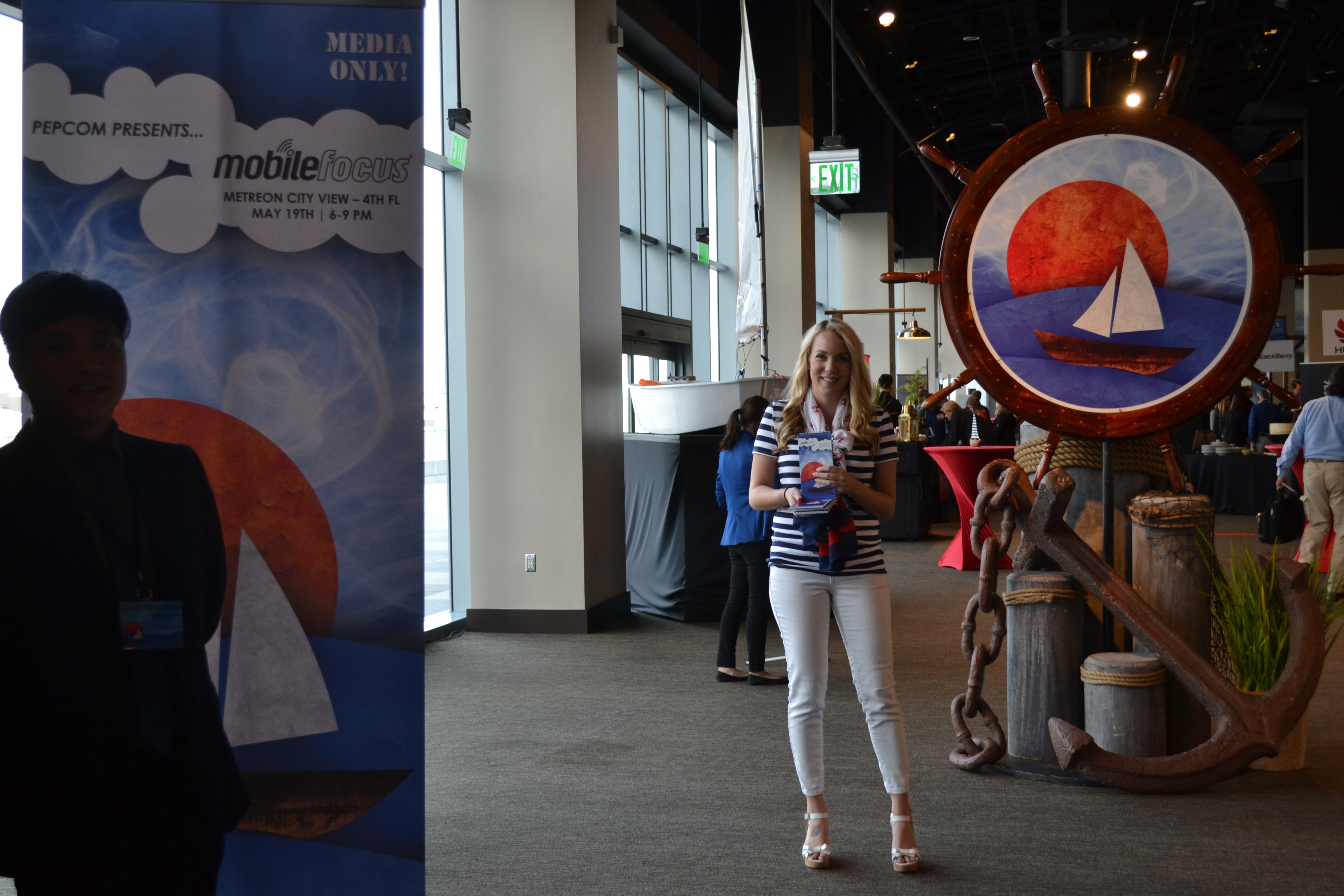
by Lidia Paulinska | Jul 11, 2016
Pepcom event, June 2016 – There is nothing not to like about Pepcom’s press only events. They are always well organized and have so many innovative products to see. The event happened on the evening of Thursday, May 19th, at the Metreon in San Francisco and focused on mobile products. 21 companies showcased their automotive, mobile and lifestyle innovations at the venue.
Here are take some of the products that I was most excited about:
Moshi, a designer of fashion bags, presented the Helios Lite and Helios backpacks that can carry laptops up to 13”(Helios Lite) and 15” (Helios). Made from ultra-lightweight and durable materials with water-repellent coating that protects in different weather conditions. All Moshi bags are very practical with enough pockets to put your valuables and accessories such as pens, chargers, smartphones and cables, as well as being fashionable for a generation of professionals that lead a busy and demanding lifestyle.
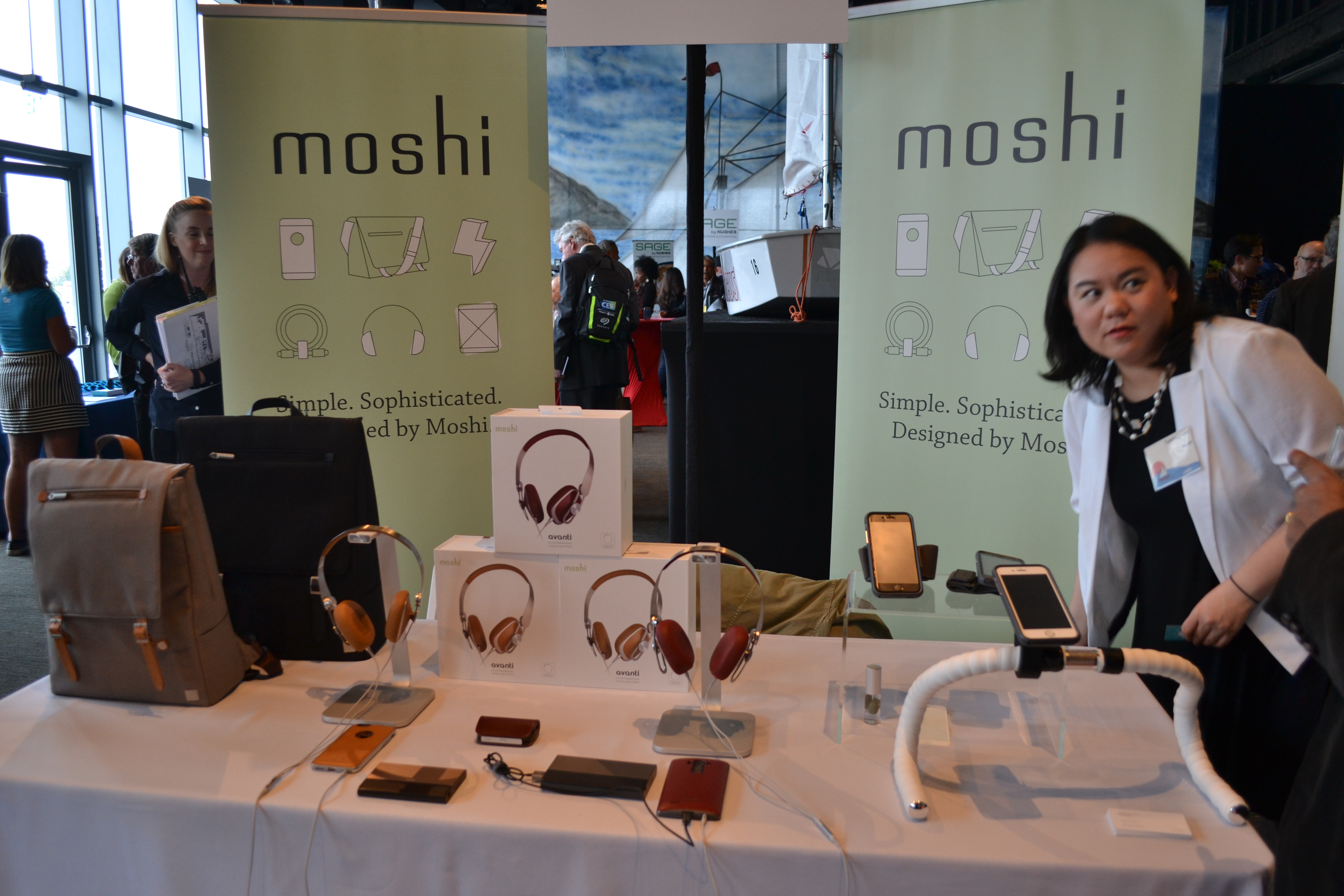
Looking over their other products at the Moshi’s table, I found another nice surprise that was on display. They presented the Avanti; Moshi’s flagship on-ear headphones. This stylish product has good sound and featured a nice ergonomic design. The curved stainless steel headband with soft adjustable ear cups made of soft leatherette lets us solely enjoy the music, which is being isolated from noise and with minimal pressure on the ears. Avanti headphones features high-efficiency 40 mm drivers with high dynamic range.
At the Kingston booth, along with their flagship products, the company division HyperX showcased their latest gaming headset; the HyperX Cloud Revolver, which is now shipping on Amazon, Best Buy and Newegg. The HyperX Cloud Revolver is made with a steel frame suspension design, memory foam and premium leatherette ear cups and headband. It is compatible with PC, console and mobile devices. Their latest version continues to bring high performance products from Kingston Technology using the Cloud.
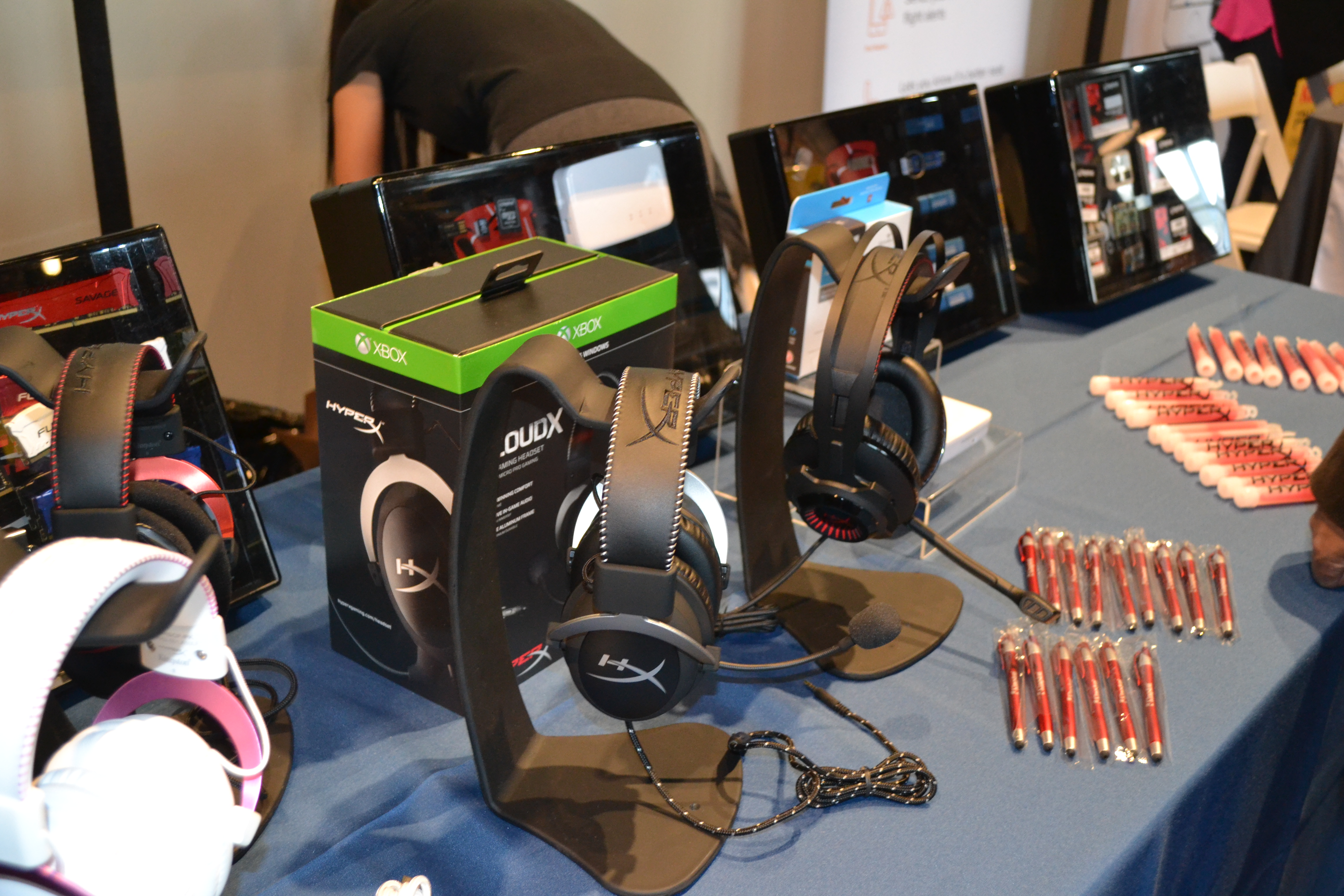
Escort Inc. and Cobra Electronics, held by Cedar Electronics, showcased an array of dash cams: DriveHD Dash Cams and Drive HD CDR895D, which provide help capture against unexpected accidents on the road. The newest addition, CDR 895D is a dual channel dash cam that simultaneously captures the road ahead and road behind in HD video, offering front view resolution of full 1080P HD and rear view of 720P HD. The CDR 895D will be in Q2 with a MSRP of $229.95.
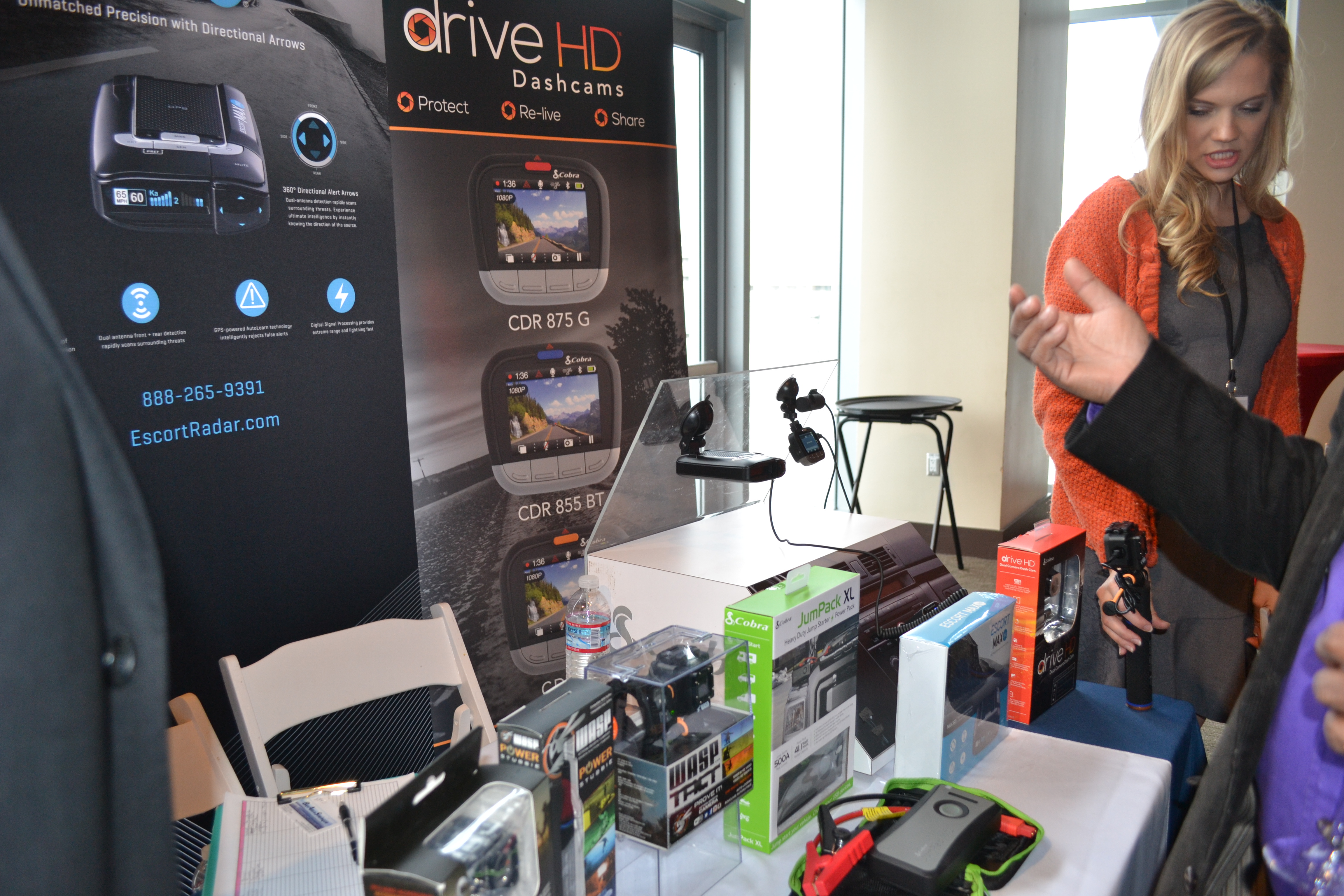
As we live in the mobile era we can’t forget that every device needs to be charged.
Ventev at its booth offered an array of charging hubs and power solutions. Along with new USB charging hub rq600, there were desktop charging hub s500, USB charging hub 400, global charging hub 300 and wall charging hub 200. On the portable power site, Ventev showcased power cells 10000+, 6000+, 6000c, 6000 and power dash r900. The company is also well known as a producer of cables that are strong, tangle-resistant and optimized.

At the end of my list, I would like to mention TripIt, a mobile application that allow you stress-free travel. The program allows to create a master itinerary for your trips and store your travel plans along with maps and directions in one place. It’s a great addition to your busy lives.

by Lidia Paulinska | Jul 1, 2016
E3, June 2016 – Noel Lee, the founder of Monster Cable, is an entrepreneurial icon in the audio & music industries. He personally designs and tunes every headphones that the company manufactures. Since early 2000s he is active in gaming industry and he presented his products at E3 show this year.
In the new presence at the show, Monster was showing off their high performance wireless products, their high power portable devices, automotive audio and the flagship for the show, their Fatal1ty by Monster gaming headsets. These were announced at CES 2016 and are the joint creation of Monster and video gamer Johnathan “Fatal1ty” Wendel, who set the world standard for competitive video gaming by capturing 12 World Championship e-Sports titles.
Creativity, Innovation and Music Matter is Noel’s favorite statement.
He started his company 37 years ago. Monster Cable & Monster Power was born in Noel’s garage. Today he holds 567 patents and has made milestones in design, comfort & performance. With successes like Beats by Dr. Dre he has now moved beyond the status quo, trailblazing with higher-performance headphones/speakers with Pure Monster Sound that Noel personally designs and tunes himself.
Here is Noel’ story.
In 1968 Noel Lee graduated from Cal Poly, San Louis Obispo and joined Lawrence Livermore National Labs’ engineering team. Six years later he left Lawrence Livermore Labs to go on a world tour with his band, Asian Wood. But he did not quit his engineering talents to create a better way to listen to music than through a zip cord. On June 26th, 1978 he registered his new company name “Monster Cable” and began production in his garage in San Francisco. Year later Lee created the first Monster cable and showcased it during summer CES in Chicago. In 1980 his company moved out of the garage to first office 101 Townsend Street in San Francisco. Lee hired his first employees, Tai Min and Shang Yu Chang, who are still with the company today. In 1998 the company moved again to the new headquarters in Brisbane, California.
Of the 567 patents that Noel holds, the first U.S. patent was for the Xterminator electrical connector (1983). He introduced to the market many products: The MacSpeaker, the first computer speaker (1985), Music Logo (1986), Monster XP, the first new high-performance cable since the original Monster cable was born (1991), M Series, with the introduction of a new line of high-end speaker cable (1992). There were also many awards such as three innovation awards for Monsterous product in 2001.
In 2008 he was awarded with the title of “Enterpreneur of the Year” by Ernst & Young after he introduced Monster Game, a new product line for PS2, XBOX and Gamecube. In 2009 he launched Monster iSport headphones and made his appearance in gaming industry. The Fatality headset is his newest premium product that targeting the gaming space, and it was the basis of Monster’s first appearance at the E3 expo. Monster has held a long tradition of having a major presence in consumer, professional and technical trade events and expos, and now the gaming industry has them in their fold.
Page 15 of 24« First«...10...1314151617...20...»Last »













